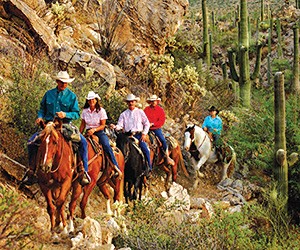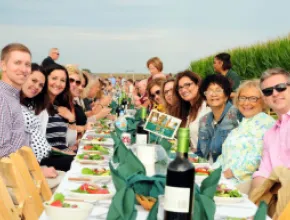Sure, saddling up your executive team for a dude ranch getaway may involve some horsing around, but the modern-day luxury range-retreat experience offers much more, with a personalized level of service that’s hard to corral in your typical hotel or resort environment.
“For executives coming in, it’s a little more personal, says Collen Hodson, executive director of the Dude Ranchers’ Association, a Cody, Wyo.-based organization representing more than 100 accredited members that follow the core principles of “horses, hats, hospitality, heritage, honesty and heart.” “When you come into someone’s ranch, they’re going to know your group, they’re going to know everyone’s name—it’s a little more personalized. Attendees get to bond, and there’s so many teambuilding opportunities they can do that they can’t do at a hotel; teambuilding with horses, teambuilding with ropes courses.”
Hodson says the guest-to-staff ratio at many dude ranches oftentimes is one staff member to one-and-a-half attendees, and because the number of guest rooms is typically smaller than a traditional hotel, groups can meet in a sequestered environment with a run of the ranch.
Activity options can range from horseback riding and fly-fishing to river rafting, ziplining, wall climbing, ropes courses and evening activities with serenades by cowboy singers and line dancing. Team-penning, in which groups of three or four participants mount horses in an arena to cut cattle into pens is a popular teamwork-building program.
“There’s a lot you can do at a dude ranch that you can’t at a hotel, and most of that is included in the price,” she says.
And if one’s impression of the culinary offerings at a dude ranch centers around fireside cowboy grub, Hodson says a realignment of F&B expectations may be in order.
“A lot of people think City Slickers—hot dogs and beans,” Hodson says. “But that’s not true. A lot of our ranches have Le Cordon Bleu chefs on staff, with a lot of farm-to-table cuisine.”
Location and accessibility are important factors to take into account when considering a dude ranch, as air access and ground transportation can sometimes translate into three or four transfers to get attendees on-site. Groups that put a priority on cell service and Wi-Fi may run into challenges, too, depending on their choice of ranch.
“There is one ranch that told attendees ‘Everyone throw your cell phones in this basket; we’re not going to use them for two days,” Hodson says. “They were apprehensive at first, but by dinnertime, everyone was relieved.”
Hodson says that a good meeting duration is three days, but in the end it all depends on the group’s specific needs, and many attendees tack on an extra day to enjoy the wide range of activities available.
The Dude Ranchers’ Association serves as a conduit for meeting planners seeking to identify which ranches may serve the goals of their retreat best. After planners get in contact and provide information such as the size of the group, what they expect and other needs, the association basically takes over the process.
“The dude ranch will pretty much do anything the planner requests, and if not, they’ll tell them far up front,” Hodson says. “There’ll be no surprises once they walk on-property.”







